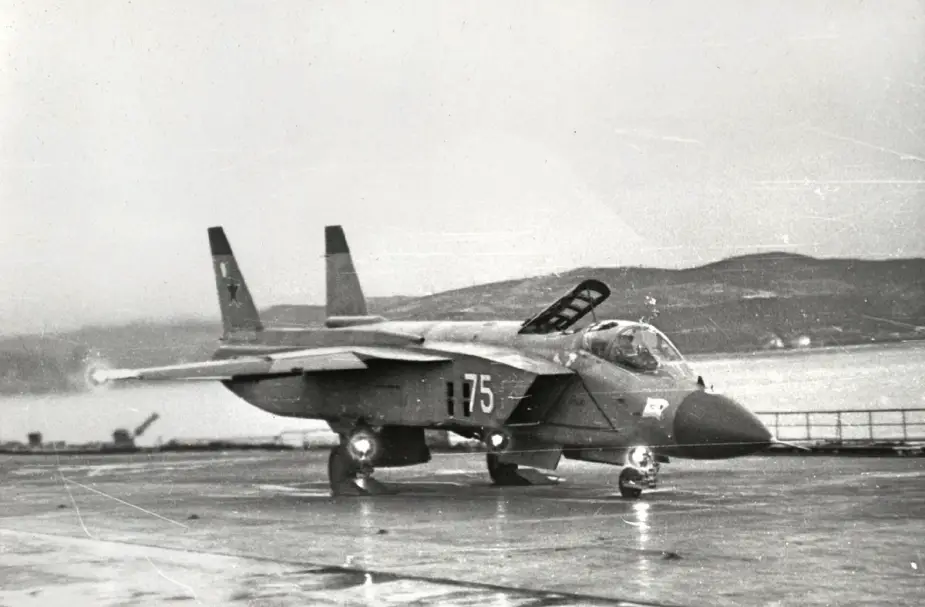Will Russian Navy Get LHDs with VTOL Aircraft ?
Denis Manturov, the head of the Russian Ministry for Trade and Industry, and the vice-premier Yuri Borisov have revealed the prospects for the Russian aircraft carriers. Two statements, made almost simultaneously, throw light on the future of aircraft carriers for the Russian Navy, the Izvestia newspaper reports.eports.
 A Yak-141 aboard a Soviet Kiev-class aircraft carrier. The Yakovlev Design Bureau started developing the Yakovlev Yak-141 (Freestyle) multirole supersonic VTOL fighter jet in the mid-1970s. The plane performed its first flight in 1987.
A Yak-141 aboard a Soviet Kiev-class aircraft carrier. The Yakovlev Design Bureau started developing the Yakovlev Yak-141 (Freestyle) multirole supersonic VTOL fighter jet in the mid-1970s. The plane performed its first flight in 1987.
Manturov was the first to speak about it. "No plans are made to build helicopter carriers exclusively for the Russian Navy. I should only note that the shipbuilding program envisages construction of universal landing craft whose landing facilities (helicopter wing, landing craft, and floating armor) are supposed to be placed inside the ship hull or on the ship deck," he said. (Ed. note: Universal landing craft or ULS is the Russian designation for Landing Helicopter Dock (LHD) type of amphibious assault ships).
After this, the speaker on the related subject was Borisov. He stated that the Defense Ministry was developing a concept of a new vertical takeoff aircraft. According to him, the work has been in progress since 2017 and is due to take 7 to 10 years.
Let us review the emerged information and piece together a picture. Manturov’s statement is the easiest to understand. The head of the Ministry for Trade and Industry aired a very obvious thing, saying that Russia does not plan to build helicopter carriers "for helicopters’ sake". Actually, this has been clear since long ago given that the era of "honest" helicopter carriers, begun in the 1950s and associated with reconfiguration in the US and the UK of the war times’ aircraft carriers, was essentially a short-lived episode. As early as the 1970s, construction began of more able and universal ships. Assault helicopter carriers are divided in two main groups, i.e. helicopter carrying assault ship docks whose main landing means are boats and auxiliary means are a helicopter group; and universal landing craft that have a more powerful air group optionally including vertical takeoff aircraft.
Since the 1960s, the USSR has built two Project 1123 helicopter carriers, then passing on to construction of Project 1143 heavy aircraft carriers that had brought together the armament of a missile cruiser and an air group that included takeoff and ant-submarine aircraft.
 Priboy LHD scale model showcased by Krylov during Army 2016 exhibition.
Priboy LHD scale model showcased by Krylov during Army 2016 exhibition.
As time went by the Soviet Navy was to receive aircraft carriers with a conventional takeoff and landing aircraft and universal landing ships capability. However, it had never come to that: the Admiral Kuznetsov was the sole ship able to carry conventional aircraft. Over time, the talks about Russian aircraft carriers implied in the first place the resumption of building aircraft carriers as such. However, in the late 2000-ies an issue again arose of building universal landing ships. Eventually, it was decided to resort to foreign experience by ordering two universal landing craft from France. The Vladivostok and Sevastopol ships built for the Russian Navy had not been handed over to the customer on account of the 2014 developments.
The development of a domestic alternative to the Mistral craft became an issue right after the crisis issued. The case in point was two main version, i.e. landing craft based on the Dutch Project Rotterdam ship /Jan de Vitt/ , or the "aircraft carrying ULS" similar to Mistrals but, probably, larger and faster. The second version could be defined as an intermediate type. That is, it was on the one hand cheaper than a classical aircraft carrier with a fully fledged air group, and, on the other, it provided excellent capabilities for insertion into distant operations oversea.
For a full realization of its capabilities such a ship needs vertical takeoff and landing (VTOL) aircraft. The most interesting issue that arises here is which aircraft model would be used. What comes to mind is, of course, the unfinished Soviet project of the VTOL Yak-141 supersonic aircraft. However, 30 years have passed since then and its mechanical reproduction would hardly make sense. At the same time, the borrowing of key technologies to ensure the vertical takeoff combined with development of the thrust vector and creation of small effective radars and other equipment make this problem.
The above-mentioned timeframe also begins to look realistic within a certain system. Creation of the VTOL system, if now in progress and initiated in 2017, may lead to a flight of the first experimental prototype in 2022-2023 and the launch of the machine in series production in the late 2020s. If in 2021-2022 construction begins of the ULS, by the time of its technological readiness the aircraft too will be ready, the Izvestia newspaper reports.
© Copyright 2018 TASS. All rights reserved. This material may not be published, broadcast, rewritten or redistributed.


























